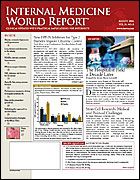Hospitalized Patients Not Receiving Thromboembolism Prophylaxis
WASHINGTON, DC—Physicians treating patients who are facing surgery or who have medical conditions associated with a risk for venous thromboembolism (VTE) often disregard prophylaxis guidelines, according to data presented at the American Heart Association’s 7th Scientific Forum on Quality of Care and Outcomes Research in Cardiovascular Disease and Stroke.
In a retrospective study of 123,304 patients (aged ≥40 years) hospitalized for conditions that are known to be associated with VTE as an added complication, prophylactic treatment was most often ignored. Conditions included acute myocardial infarction, ischemic stroke, cancer, heart failure, severe lung disease, surgery associated with a high risk for VTE (ie, orthopedic, general, gynecologic, urologic, or neurosurgery), and spinal cord trauma.
VTE events increase the risk for mortality or long-term morbidity, said coinvestigator Robert W. Dubois, MD, PhD, chief medical officer, Cerner Health Insights, Beverly Hills, Calif.
The Sixth American College of Chest Physicians guidelines recommend prophylaxis with low-molecular-weight heparin or low-dose unfractionated heparin for most patients at risk for VTE, although in some cases unfractionated heparin is not advised, or warfarin or intravenous heparin is recommended instead. Investigators defined compliance as administering prophylaxis at the proper dose starting within 2 days of admission and continuing for at least 7 to 10 days postsurgery.
Analysis revealed a compliance rate of only 13.3%, with the highest rate for patients undergoing orthopedic surgery (52.4% of 2324 patients) and lowest for those undergoing neurosurgery (2.8% of 5768 patients). Other rates included 12.7% (of 35,124 patients) for general surgery, 9.9% (of 1388 patients) for urologic surgery, 4.4% (of 7469 patients) for trauma, and 2.8% (of 5768 patients) for neurosurgery.
Only 15.3% of the 62,012 patients with medical conditions associated with VTE risk were treated according to guidelines. About 10% of the cases received an inadequate length of prophylaxis; the other 90% received none.
He noted that the risk of bleeding during a short course of prophylaxis in patients who have already had a blood clot is only 2% to 3% in a 1-year period, although the risk of a recurrent blood clot rises to 5% to 10%.
Dr Dubois said that contraindications to prophylaxis would not explain the 47% noncompliance rate in the orthopedic surgery patients or the 85% noncompliance rate in at-risk medical patients. “Even with the higher awareness of VTE risks among orthopedic surgeons, about 25% of patients received no VTE prophylaxis whatsoever,” he said. “As an internist, I was both surprised and disturbed.”
Successful strategies may offer solutions:
• Feed findings back to individual physicians and hospitals.
• Modify the hospital process to include automatic alerts about prophylaxis within electronic medical records.
• Incorporate compliance with prophylaxis into the Joint Commission on Accreditation of Healthcare Organizations evaluations and hospital payment formulas.
